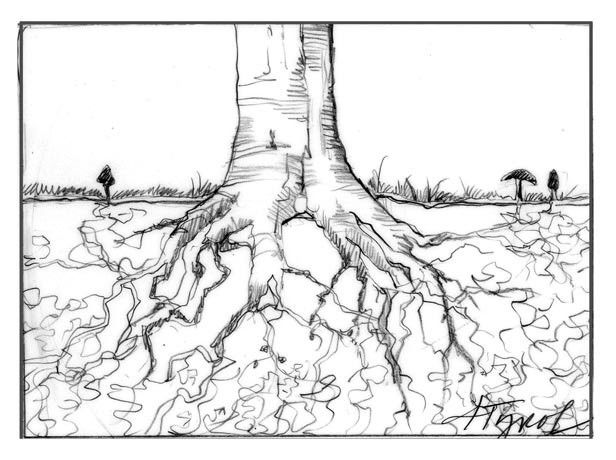
Most people, when they look at a tree, look up. Understandable. The trunk lofts limbs skyward, unfurling a shimmering sunlight-gulping net of leaves. But with a little imagination (and, more practically, a microscope), it can be just as interesting to look down, at the roots beneath the forest floor.
The rule of thumb holds that 20 to 25 percent of a tree's biomass is underground, in the roots. Most roots are in the top two feet of soil and, as a general rule, they occupy an area two to four times the diameter of the tree’s crown. Roots anchor the tree in place and collect nutrients and water from the soil. But they’re not working alone.
Look closely, and you’ll observe that where there are tree roots, there are mycorrhizal fungi, the Pavarottis of the forest soils’ opera. These fungi aren't the same as the ones breaking down rotting logs. They're working with the tree roots, absorbing water and nutrients for the tree to use. In return, the tree shares some of the carbohydrates it creates through photosynthesis. It's a symbiotic relationship: like the one between the honeybee and the flower. Or you and your gut bacteria. Or the fungus and the alga that bond together to make lichens.
I like to think of the relationship between a tree and its mycorrhizal fungi as an artful marriage where the two partners complement each other. Some of my friends might describe my marriage like that. (I know, I'm considered the fungus in this analogy.)
“What fascinates me is just how evolution and natural selection got these two organisms to be living in combination and dependent on the other,” said Mike Cline. (For the record, he's talking about trees and their fungi, not my wife and me.) A plant physiologist, Cline studied mycorrhizal fungi and trees in graduate school and went on to do research on them for International Paper Company. He now runs the Tin Mountain Conservation Center in New Hampshire.
The importance of the relationship between trees andmycorrhizae is generally underappreciated, he said. And fascinating in the details. There are many different species of mycorrhizal fungi and most plants, it turns out, have worked out partnerships with them. In many cases, a tree species prefers a particular fungus as a partner, lending a monogamous tone to the relationship. Other trees, however, can partner with more than a dozen. Some types of these fungi penetrate the cell walls in a plant's roots (these are called endomycorrhizae). Others weave their way between the cells of fine feeder rootlets, virtually enveloping them (they’re called ectomycorrhizae).
Roots “essentially put on a fungal glove, called a mantle,” said Cline. That glove around the roots protects it a little bit from drought. But more importantly, it increases the roots’ ability to absorb nutrients. “Think about a little short root, with root hairs sticking out a millimeter or so around it,” said Cline. “That's the absorbing area of a 'non-infected' root. The fungal glove increases the absorbing area of that little rootlet over a thousand times.”
You can see a bit of the vast underground mycorrhizal net, or hyphae, by digging down and peeling back the partially decomposed humus. There they are: white or yellow strands, like a loosely-woven fabric. The mushrooms that you notice popping through the leaf litter on rainy fall days are the reproductive bodies for the underground fungus. They spread the fungus’s spores.
Trees and their mycorrhizae differ from forest type to forest type around the globe. No one knows how many mycorrhizal species there are, but estimates range up to 25,000. There is no question that they are important, that they literally make the forest possible. Given that humans have more effect on forests than anything else, we should at least be aware of them. “It's important to develop a better understanding, so it's not out-of-sight, out-of-mind,” Cline told me.
In the end, these lowly, largely unnoticed organisms can also serve as a reminder that John Muir was right when he said, “when we try to pick out anything by itself, we find it hitched to everything else in the universe.”


Discussion *